Vol 4 No. 22 TROPIC LIGHTNING NEWS June 2, 1969
Index
Fire Brigade Units Join To Crunch NVA Base
SP4 Art Brown
CU CHI - In two days of heavy contact 12 miles northwest of here 2d
Brigade units struck a smashing blow against a regimental-size NVA base camp.
The 2d Battalion, 12th Infantry Warriors with elements from the 1st
Battalion (Mech), 5th Infantry, killed 92 enemy and destroyed their heavily
fortified base camp.
Delta Company Warriors walked into the base camp about 10:00 a.m.
and spotted an enemy soldier dressed in camouflaged clothing. Firing on
the insurgent brought a hail of fire from the covered and well-entrenched NVA.
Their advance halted by enemy fire, the GI’s called for close
artillery and gunship support to cover their withdrawal to a distance.
This permitted tactical air strikes on the solidly entrenched Communists.
“They couldn’t retreat, because the Mech was set up in a
blocking position,” said Sergeant James Rogers of Lowellville, Ohio. “They had to stay and take it.”
With pinpoint accuracy, artillery from the 3rd Battalion, 13th
Artillery, and 1st Battalion, 8th Artillery, cleansed the area with fire.
Good synchronization with the Air Force brought their ordnance on the target
zone after the artillery barrage lifted.
Later in the afternoon, the infantrymen stormed the enemy positions
and blasted Charlie out. The Warriors’ Bravo Company joined the hassle
via eagle flights shortly after the action began and moved in with the men from
Delta.
Major Billy W. May, Bavoula Batre, Ala., left his LOH to control
operations on the ground. His direction was instrumental in the
overwhelming victory.
The entire base complex was destroyed by air strikes, artillery,
and demolition. “It was the best constructed and camouflaged emplacement
I have ever seen,” said Captain John K. Taft of Youngstown, Ohio. Some
of the 60-70 bunkers were 20 feet by 20 feet and six feet high with logs and
three or four feet of dirt overhead. Tunnels connected most of them.
“The enemy had an underground kitchen complex complete with
entrance and exit, but they’ll never use it again,” stated Specialist Four
Elmo Hubbard of Holly Spring, Mich.
The following morning, men of Company A, 1st Battalion, 5th
Infantry, added their fire power to the Warriors’ by storming the base again
and mopping up.
“Those tracks sure put out the firepower,” added Specialist
Four Sammy Brown, Shreveport, Mich. “They blocked the enemy in the first
day and assaulted with us on the next morning.”
 |
WET - Sergeant Raymond K. Thomas of Scottsdale, Ariz., of the 2d Battalion, 27th Infantry Wolfhounds crosses a chest-deep river. (PHOTO BY SP4 ROBERT B. WILLIAMS) |
PFs, 2/34 Swarm VC
CU CHI - The Viet Cong made a bad mistake when they tried to move
into a thickly wooded area seven miles north of Cu Chi recently.
Their movements were not unnoticed. Elements of the 2d
Battalion, 34th Armor, working with a company of Vietnamese Popular Forces from
Peri Tan Qui watched carefully and then made a devastating strike.
Approaching a stream that empties into the Saigon River, a forward
element of the Dreadnaughts’ Armor spotted an estimated platoon of Viet Cong
hastily leaving the area.
When the Popular Forces made contact, the Tropic Lightning armormen
zigzagged around them and gave chase to the retreating enemy soldiers.
“For a while it looked like a giant Keystone Cops chase scene,”
said one soldier.
Staff Sergeant Walter Daniel of Rocky Mount, N.C., ran into a
typical situation. Zipping around a bomb crater the Dreadnaught
Headquarters Company tank commander spied several enemy on the far side of a
hedgerow “trying to run a three-minute mile.” One of the VC ducked out
of sight. Another one, however, never made it.
Two more enemy were killed in similar actions. The entire
contact lasted 15 minutes.
|
Going Home? If you obey common sense safety rules, both you and your buddy have a better chance of returning to the world at DEROS. |
35 Enemy Fall to Bobcat, Warrior Might
CU CHI - Company A, 1st Battalion (Mechanized) 5th Infantry,
recently initiated a lopsided firefight from their night defensive position in
the Citadel area. Acting with one platoon from the 2d Battalion, 12th
Infantry, the combined units killed 35 NVA in an unorthodox way.
After the 2d Brigade soldiers had dug in, Captain Bud R. Brown of
Fayetteville, N.C., ordered a test fire. Just as the perimeter opened up
to test their weapons, an illumination round from one of the company’s mortar
tubes lighted the forms of nearly 30 enemy attempting to sneak in on the site.
Simultaneously, the test fire shattered the enemy’s plans to
infiltrate the perimeter. The flare-lit sky revealed a disorganized mass
scurrying to escape a hail of .50 caliber machinegun fire.
After the initial sighting and during the subsequent firefight, the
only incoming fire came from small arms, indicating that the enemy was hardly
ready to co-ordinate an attack. The Bobcat unit received none of the
customary RPG or mortar fire from enemy weapons.
The enemy’s lack of preparation was clearly shown when First
Sergeant Lloyd Storey of Augusta, Ga., called in mortar fire on the insurgents.
One of the rounds apparently hit an NVA ammo bearer with an armload of RPGs, and
the resulting secondary explosion caused the rockets to fire in every direction.
“It looked just like the Fourth of July back in the world,” said one of the
Tropic Lightning soldiers who witnessed the display.
Storey’s replacement (Storey had only two weeks left in country),
First Sergeant Ervin Eisenhauer of Saginaw, Mich., attributed the success to the
early sighting. He said, “We definitely caught them in an embarrassing
spot. They hadn’t even thought of getting into attack position when we
spotted them.”
Specialist 4 Richard Randel of Enumclaw, Wash., also commented,
“I’m sure that not allowing them to get into an offensive position was
responsible for the lack of U.S. casualties.”
The Bobcat Company was able to catch a fair night’s rest after
the action, as the fighting only lasted until midnight. A sweep of the
contact area the next morning resulted in 35 NVA body count, five AK-47 assault
rifles, 1 RPG launcher, eleven RPG-7 rounds and four rifle grenade adapters.
Destroyed were eleven AK-47s, two RPG-2 rounds, 60 pounds of rice and six
grenades.
 |
SOUP FOR LUNCH - Specialist 4 Gerald McPherson of Edwardsville, Ill., digs into a can of tomato soup on a lunch break during a mission with the 2d Battalion, 27th Infantry Wolfhounds west of Tay Ninh. (PHOTO BY SP4 ROBERT B. WILLIAMS) |
Page 2 TROPIC LIGHTNING NEWS June 2, 1969
Decorated
| BRONZE STAR MEDAL |
|
| 1LT Joseph H. Martin, Co B, 1st
Bn, 5th Inf CSM Robert Glotz, HHC, 2d Bn, 22d Inf 1SG Joseph Gooden Jr, B Btry, 2d Bn 77th Arty 1SG Henry Paolille, HHC, 1st Bn, 5th Inf PSG Charles W. Green, Co D, 1st Bn, 27th Inf SFC Everett B. Copsey, Co B, 65th Engr Bn SFC James T. Dixon, D Btry, 3d Bn, 13th Arty SFC Robert A. Seaver, HHC, 3d Bn, 22d Inf SFC Almin D. Autry, HHC & Band, DISCOM SSG Robert C. Heafey, HQ & Co A, 25th Med Bn SSG Elmer R. Martin, HHS, DIVARTY SSG David L. Bishop, 372d RR Co SSG John I. Dinger, HQ & Co A, 25th Med Bn SSG Charles M. Fry, C Btry, 7th Bn, 11th Arty SSG Larry J. Hollis, Co D, 2d Bn, 14th Inf SSG Alfred Norris, HHC, 65th Engr Bn SSG Edward A. Putney, Co B, 65th Engr Bn SSG Jerry D. Helm, Co A, 2d Bn, 14th Inf SSG Steven G. Hanes, 25th MP Co SP6 Robert R. Caudillox, HHT, 3d Sqdn, 4th Cav SGT Richard S. Clampitt, Co B, 65th Engr Bn SGT Tony Tew, Co B, 4th Bn, 9th Inf SGT Don H. Lascelles, Co A, 3d Bn 22d Inf SGT Donald N. Barrest, Co C, 2d Bn, 12th Inf SGT Gerry G. Semmler, Co B, 1st Bn, 27th Inf SGT Neal E. Prodbenski, Co B, 1st Bn, 27th Inf SGT Richard C. Betten, Co E, 4th Bn 9th Inf SGT Arthur F. Di Petrillo, Co C, 2d Bn, 12th Inf SGT James V. Dixon, HHC, 2d Bn, 34th Armor SGT Michael P. Feudo, Co A, 2d Bn, 14th Inf SGT Clyde A. Kingman, Co D, 2d Bn, 14th Inf SGT Bruce A. Locke, Co A, 2d Bn, 14th Inf SGT Justin E. Smith, Co C, 2d Bn, 14th Inf SGT Homer C. Hamer, HHC, 2d Bn, 34th Armor SGT James R. Heath, HHC 2d Bde SGT John Long, HHC 2d Bn, 22d Inf SGT William E. Roush, Co A, 2d Bn, 34th Armor SP5 Dexter E. Pritchard, HHC, 2d Bde SP5 Larry J. Kirian, HHC 2d Bn, 34th Armor SP5 Richard L. Gray, HHC, 3d Bn, 22d Inf SP5 John C. Black, HHC, 1st Bn, 27th Inf SP5 Anthony R. Haggard, HHC, 65th Engr Bn SP5 Donald B. Covington, HHT, 3d Sqdn, 4th Cav SP5 Robert MacFarland, Co C, 1st Bn, 5th Inf SP5 Billy C. Morton Jr, Co C, 25th S&T Bn SP5 Richard Kerkoff, Co C, 1st Bn, 27th Inf |
SP5 Francis Benoit, Co C, 65th Engr Bn SP5 John M. Richey, 373d RR Co SP5 Steven A. Sadowski, HHC, 2d Bn, 14th Inf SP5 Michael S. Ruszak, Co A, 2d Bn, 22d Bn SP5 Gary P. Brown, 25th Admin Co SP5 James L. Day, HHC, 2d Bn, 34th Armor SP5 Jan Vecchini Jr, 2d Bn, 14th Inf SP5 Thomas L. Shunk, HHC, 65th Engr Bn SP5 Edward J. Smith , 372d, RR Co SP5 Gary S. Wigley, 25th Admin Co SP5 Thomas Williams, HHC, 2d Bde SP4 Larry J. Warner, Co B, 65th Engr Bn SP4 Willie Best, HHC, 1st Bn, 5th Inf SP4 Norman L. Hooks, Co E, 65th Engr Bn SP4 John Shields Jr, A Btry, 2d Bn, 77th Arty SP4 Monte D. Christ, HHC, 2d Bde SP4 Rodney E. Olson, HHC, 2d Bde SP4 David L. Weersing, HHC, 2d Bde SP4 Jerry C. Bradshaw, Co C, 1st Bn, 27th Inf SP4 Robert L. Penick, Co C, 65th Engr SP4 John H. Omeara, Co E, 65th Engr Bn SP4 Danny L. Hugnes, Co B, 1st Bn, 27th Inf SP4 Richard D. Herzog, Co B, 1st Bn, 27th Inf SP4 Patrick T. Mahoney, HHC, 2d Bn, 12th Inf SP4 Gilbert J. Mims, Co B, 65th Engr Bn SP4 Andrew Alday III, Co A, 3d Bn, 22d Inf SP4 Edward S. Stafford, HHC, 4th Bn, 9th Inf SP4 Jacob R. Johnson, Co C, 65th Engr Bn SP4 Patrick W. Tobin, Co C, 1st Bn, 27th Inf SP4 Donald A. Spory, HHC, 65th Engr Bn SP4 Rex W. Oldham, HHC, 65th Engr Bn SP4 Danny L. Hughes, Co B, 1st Bn, 27th Inf SP4 John C. Paxson, Co B, 1st Bn, 27th Inf SP4 Larry J. Warner, Co B, 65th Engr Bn SP4 Leroy L. Hanson, Co B, 1st Bn, 27th Inf PFC Horace J. Scott, Co A, 3d Bn, 22d Inf PFC John W. Schoenberger, Co B, 1st Bn, 27th Inf PFC Claude W. Todd, Co C, 1st Bn, 27th Inf PFC Anthony S. Tubbs, Co B, 1st Bn, 27th Inf PFC James A. Roberg, Co B, 1st Bn, 27th Inf PFC John F. Burr, Co C, 1st Bn, 27th Inf PFC Thomas Sanchez, HHC, 1st Bn, 5th Inf PFC Earl M. Martin, Co C, 1st Bn, 27th Inf PFC Joe H. Black, Co B, 1st Bn, 5th Inf PFC Hugo Zimmerman, Co C, 1st Bn, 27th Inf PFC Ronld J. Zollner, Co B, 1st Bn, 27th Inf |
With Marijuana Pot Luck Means Bad, Bad Trouble
It was a black and rather lonely night. The darkness had
cooled the night air and a pleasant breeze filled the compound. The guard
stood silently in the corner smoking. His motor pool was secure.
Suddenly out of nowhere, dark eerie shadows broke the stillness of
the motor pool. VC had completely surrounded the area. The
guard dropped his cigarette and commenced firing his weapon wildly into the
night. He had had it now - life and property were unsafe - danger lurked
in every corner; VC were all around, there was no escape.
Chaos came out of order - utter madness, complete unreality, and
unreality it was, for when lights were turned on and events brought back under
control, the only thing surrounding the guard was the bullet riddled vehicles
themselves. The cigarette that had been tossed down by the guard contained
marijuana and he was incapable of discerning anything but his own imagination of
his own unreal world. A pathetic creature - a man no longer a man, who
lost all control of his free will. He was a virtual slave to a piece of
plant called “cannabis sativa” or marijuana.
“Caution - Cigarette smoking may be hazardous to your health”.
Sound familiar? You bet it does. But what about marijuana, brass,
pot, reefers, and joints as it is sometimes referred to by users? It’s
all the same, no matter what it is labeled, and it certainly is a health hazard;
your health and those around you. A marijuana smoker is a potential hazard
to all who come in contact with him.
The consumption of marijuana (or hashish) produces a variety of
immediate mental and physical effects which become more pronounced with chronic
use. It affects not only you but the safety and well being of your
buddies, and the overall efficiency of your unit. Among the more prominent
effects of marijuana are: hilarity, carelessness, distortion of sensation and
perception, impairment of judgement and memory, distortion of emotional
responsiveness, irritability and confusion, illusions and delusions, anxiety and
aggressiveness, intellectual and sensory derangements, lethargy and
self-neglect, psychotic episodes or impulsive behavior in reaction to fear or
panic.
The major danger of using marijuana is that the person who is high
is a broken link in the human chain in a combat zone where the lives of many
depends upon the action of each individual.
Vietnam abounds in a ready access to marijuana, and many a GI is
lured into trying it. Some try it just for kicks because a friend may
persuade him, others try it in misbelief that it helps them escape from the
unpleasant atmosphere of a combat environment, and some try it just out of
curiosity - as a relief from boredom. In any case it is apparent that
those doing so do not understand the seriousness and costly consequences of
their acts. For example:
1. In addition to physical degradation and any disciplinary action
which might be taken under the UCMJ, a copy of the case of every military
narcotics user is forwarded to the Federal Bureau of Narcotics and Dangerous
Drugs. The user, who may only be experimenting, accrues a police record
that will follow him the rest of his life.
2. The Narcotics Control Act of 1956 requires that a certificate be
issued before a border crossing by a narcotics addict or violator. This
includes registration into and out of the United States.
3. The impost of special taxes on narcotics buyers and sellers.
4. Social stigma in a society which considers narcotics addiction
repugnant.
Marijuana smoking is often a first step towards a deterioration of
the individual’s character and personality. It could lead to increased
reliance on drugs or addiction to a hard narcotic such as heroin.
Is it worth the price? Listen to the experts - marijuana is a
hazard. It can harm you and your friends. It has no place in the
lives of sensible individuals who value getting the most out of life. With
marijuana you are certainly cheating yourself out of everything this modern
world has to offer.
Free Entry Requires A PCS Order
Personnel returning to the United States under PCS or DEROS orders
should keep in mind items purchased for personal use may be mailed home duty
free.
Public law 126 provides for such duty-free entry if the person
actually has the merchandise in his possession before it is mailed. A copy
of the orders must be enclosed, and the parcel must be marked ‘Free entry
claimed under public law, movement order enclosed.’
This provision does not apply to individuals on temporary duty in
an overseas area for less than 140 days.
Tropic Lightning Tots
The Commanding General Welcomes
The Following Tropic Lightning Tots
To The 25th Infantry Division – As
Reported By The American Red Cross.
Born To:
| May 3 PFC Albert Washington, HHC, 725th Maint Bn, twin sons May 10 SP4 David Maloney, A Trp, 3d Sqdn, 4th Cav, a son May 11 SGT Walter B. Graut, Co B, 2d Bn, 12th Inf, a son May 13 PVT Charles L. Burnham, HHT, 3d Sqdn, 4th Cav, a daughter |
May 15 SGT Gregory L. Leggett, Co D, 2d Bn, 34th Armor, a son SP4 David Lynch, Co A, 25th S&T Bn, a daughter May 17 PVT Larry Briggs, HHC, 2d Bn, 34th Armor, a daughter SP4 Larry H. Hansen, Btry A, 3d Bn, 13th Arty, a son 1LT George M. Hinson, Co A, 25th Avn Bn, a daughter May 19 1LT William F. O’Connor, 25th S&T Bn, a daughter |
The TROPIC LIGHTNING NEWS is an authorized publication of the 25th Infantry Division. It is published weekly for all division units in the Republic of Vietnam by the Information Office, 25th Infantry Division, APO San Francisco 96225. Army News Features, Army Photo Features, Armed Forces Press Service and Armed Forces News Bureau material are used. Views and opinions expressed are not necessarily those of the Department of the Army. Printed in Tokyo, Japan, by Pacific Stars and Stripes.
MG Ellis W. Williamson . . . . Commanding General
MAJ John C. Fairbank . . . . . Information Officer
1LT John C. Burns . . . . . . . . Officer-in-Charge
SP4 Robert Imler . . . . . . . . . . Editor
SP5 Charles Withrow . . . . . . Assistant Editor
SP4 Ralph Novak . . . . . . . . . Production Supervisor
Page 3 TROPIC LIGHTNING NEWS June 2, 1969
Vietnamese Are Defending Vietnam
1LT J.N. Black
CU CHI - When the day does come that American forces begin
withdrawals from South Vietnam the mission of security will fall totally into
the hands of the RVN military and civilian militia.
For that reason, and with the prospect of eventual withdrawal,
Peoples’ Self Defense Cadres have been established throughout Vietnam - and
while undergoing on-the-job training these groups show great promise.
Among the forces in the 25th Division’s area of operations is a
140-man element at Phuoc Hiep village 15 miles northwest of Saigon on Highway 1.
The 140 members at Phuoc Hiep are all civilian volunteers, from 15
to 50 years of age. Only 72 members have weapons now, ranging in type from
Ml rifles to World War II Thompson Submachineguns.
That is one of the problems these local forces will have to
overcome as they build up their strength . . . more and better weapons and an
organized supply system, said Captain Walter Nakano of Makakilo, Hawaii.
Nakano is the Senior Adviser with Military Advisory Team 23 at
Phuoc Hiep. As adviser, he frequently assists the PSDF with training and
supplies.
“I think this self-defense group is very effective,” said
Nakano. “I can make a parallel only with the Minute Men of our
Revolutionary War.”
The village chief is the real man-in-charge in each hamlet, but the
operations are supervised by senior members, many of whom have military
backgrounds.
They learn marksmanship, weaponry and explosives as well as
military discipline. They operate primarily at night. Work in the
fields and paddies occupies their days.
“They are in fact right now stopping the VC from coming into the
village by setting up ambushes,” Nakano said.
Obviously peace is the objective of all their efforts, but until
that time, units such as the Phuoc Hiep PSDF cadre are proving their ability and
value to their government and are steadily pressing the Viet Cong.
| THE PATCH is a symbol of the Vietnamese patriots who toil the paddies and fields by day and man a watchpost at night. |  |
 |
I’M CALLING YA OUT, PODNER - Looking as though he may be ready to face John Wayne, this young leader gives instructions in military discipline, bearing and tactics. |
| TAKING AIM – Training in combat formations, markmanship and weaponry is taught to the Phuoc Hiep Self Defense Group by Revolutionary Development cadre members of the district. |
 |
Deuces Dump VC Ambush
DAU TIENG - Mechanized infantrymen of Alpha Company, 2d Battalion,
22d Infantry, operating in the Crescent Area three miles north of here, turned
tables on a Viet Cong ambush recently, killing one VC soldier.
The Triple Deuce company, moving into their area of operation
received small arms and RPG fire from an estimated two or three VC about 50
meters to the north. Return fire from small arms, artillery, and a light
fire team resulted in the kill.
Later, near the same area, the company received one NVA rallier.
“The rapid response of my men prevented the enemy from carrying
out the planned ambush,” said Captain David Crocker, Old Mystic, Conn., the
company commander. “This incident demonstrates what the use of fire
superiority can do to disrupt an ambush attempt.”
The mechanized company also located and destroyed 17 enemy in this
same area.
VC Sampans Sunk
DAU TIENG – Charlie Company, 1st Battalion, 27th Infantry,
operating near the Saigon River seven miles southeast of here, located and
destroyed two sampans on the banks of a small river tributary, and captured a
food cache.
The sampans, both 29 feet long and five feet wide, were found in
areas that showed signs of activity within the previous 24 hours.
The Charlie Company Wolfhounds also uncovered 100 pounds of salt,
700 pounds of rice, two three and one-half horsepower sampan engines, two five
horsepower sampan engines, four gas cans, two bicycles, one half pound of C-4
explosive, two pounds of TNT and five feet of detonating cord. The entire
cache was found in the open near the sampan discoveries.
“The enemy apparently left this area in a hurry, not bothering to
conceal his supplies,” said Captain Lloyd Yoshina of Honolulu, the company
commander. “The battalion’s reconnaissance-in-force operations, which
have kept the enemy constantly moving in this area, have no doubt contributed to
his inability to properly store his weapons and equipment,” he said.
Bobcats Are Old, But Still Spry
The 1st Battalion (Mechanized), 5th Infantry is the oldest unit in
the 25th Infantry Division.
The Bobcats were organized in 1808 in New England. They have
participated in 36 campaigns, starting with the War of 1812.
The 3d Squadron, 4th Cavalry is part of a unit formed in 1855, and
had participated in 56 campaigns, the most of any Tropic Lightning unit, before
the division came to Vietnam.
The 4th Battalion, 9th Infantry Manchus stand second in both time
of service and pre-Vietnam campaigns. The 9th Infantry Regiment was
organized in March, 1855, and had participated in 45 campaigns, starting with
the Indian Wars, before it joined the 25th Division in Vietnam.
Tower Guards on Guard
SP4 Pete Freeman
TAY NINH – Located 45 feet above the ground on the perimeter of
Tay Ninh base camp is the tower guard. His job is essential to base
security. Twenty-four hours a day, seven days a week, artillerymen from
the 7th Battalion, 11th Field Artillery, operate three of the five
‘flash-ranging towers’ on the perimeter of Tay Ninh base camp.
From these lofty positions, the tower guard has a wide view of the
countryside surrounding the base camp so that he can maintain a close watch for
“Charlie.”
Whenever a tower guard spots enemy movement or activity, he calls
in a report to provide base camp defense with the urgent information. At
night, the tower guard must keep a close watch for the flash that can be seen in
the distance whenever the enemy decides to harass Tay Ninh with a few incoming
rounds. It is at this time, that the tower guard has to perform his most
difficult duty.
He uses a “BC Scope,” a type of aiming circle. With the
scope, the tower guard takes a quick azimuth reading, which is the angle of
direction from which the flash is coming. The azimuth along with the
estimated range to the enemy location is then sent to base camp defense so that
effective counter mortar fire can be called in on the enemy position.
To spend a night on the towers and to see the flashes coming from
enemy mortar tubes in the distance during the wee hours of the morning is an
amazing experience. Moments later you can see the incoming rounds explode
inside or near base camp and the early morning silence is broken. Then,
seconds after the azimuth and range have been called in, the base camp erupts
into a rush of activity. Gun ships can be heard starting up and taking
off. Soon, artillery rounds fired from a nearby fire support base are
landing in the enemy position.
Because of the sharp eyes and accurate calculations of the tower
guards, the Viet Cong are finding attempts to strike Tay Ninh base camp
increasingly costly.
 |
| SNIPER! HIT IT! – A mound of earth provides suitable cover for Specialist 4 William Fullard of Waycross, Ga., and Specialist 4 Elisha Griffin of Cambell, Mo. The 2d Battalion, 27th Infantry Wolfhounds came under fire during a sweep near Fire Support Base Stuart. |
Page 4-5 TROPIC LIGHTNING NEWS June 2, 1969
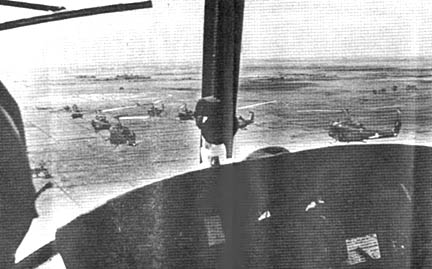 |
| EAGLE FLIGHT – Airborne and in perfect formation, the 116th Helicopter Assault Company moves troops of the 2d Battalion, 27th Infantry Wolfhounds to their landing zone. |
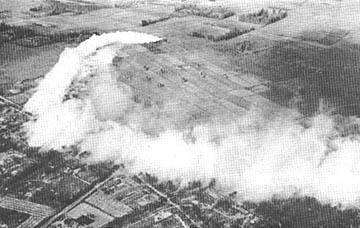 |
YOU’RE COVERED – Smokey makes a run around the landing zone as the Hornet slicks move in to drop their troops. Concealment afforded by the smoke enables the infantrymen to land hidden from the enemy and makes accurate Viet Cong fire impossible. |
| THUMBS UP – A Stinger pilot gives the thumbs up sign as two rockets streak for their target. Smoke from earlier runs is visible from another destroyed bunker. |  |
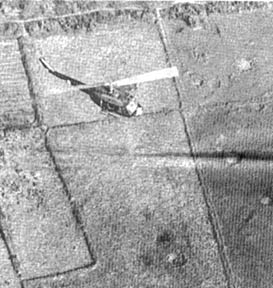 |
ON THE WAY – A Hornet slick carries its load of 2d Battalion, 27th Infantry Wolfhounds to a landing zone near Fire Support Base Diamond III. |
| READY - The command and control ship’s navigation lights glow in the early morning as the ship warms up prior to take off. | 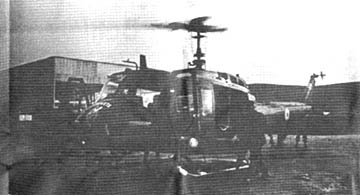 |
Hornet Choppers: Swift And Sure
CU CHI - In the three years that Hornet pilots and crewmen have
flown for the 2d Brigade, they have gained the respect and admiration of the
soldiers they serve by a routine display of precision flying and awesome
firepower.
Credit goes not only to the men at the controls, but also to the
men behind the scenes - the clerks, mechanics, supply personnel and others.
The pilots and crewmen are the ones that the infantrymen see,
therefore, they are the ones who earn his praise, and rightly so.
Precision flying has become a trademark of the 116th Assault
Helicopters. This is what the ground troops appreciate most. They
know that the Hornets will be precisely where they’re supposed to be, when
they’re supposed to be there.
Hornet Eagle Flights are beautiful things to watch. The
choppers gracefully make the numerous landings and takeoffs required to keep the
infantry on the move.
Gunships also play an important role in the support of the men on
the ground. They have added their rockets and machinegun fire in many
firefights. When the Stingers make an appearance, Charlie knows that he
may as well clear out - the firefight is as good as over.
Then there is Smokey, a helicopter fitted with a smoke-producing
device that makes a concealing cloud for Eagle landings and pickups. The
chopper has to fly ‘on the deck’ and slowly, making it a primary target for
enemy gunners.
Those are the Hornets; and without their assistance the infantrymen
on the ground would have a much harder task in fighting the enemy. Any way
you look at it, the 116th Assault Helicopter Company has been an enormous asset
to the Fire Brigade and the Tropic Lightning Division.
|
Story, Photos |
| PLANS – Major John Tregasser of Pittsburgh, Pa., works out details of an upcoming eagle flight with an operations officer while his co-pilot looks on. Tregasser is the commanding officer of the 116th Assault Helicopter Company. |
 |
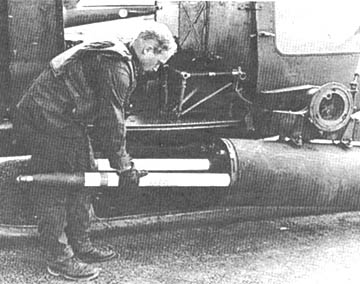 |
LOAD – Warrant Officer Kenneth Young of Nashport, Ohio, loads 2.75 inch rockets into the pods of his gunship. The gunship carries a variety of weapons, rockets, miniguns, and automatic grenade launchers. |
| FILL ‘ER UP – Specialist 5 Carl Fuerst, Command and Control Ship crewchief from Wilmington, Calif., fills his chopper’s fuel tank with JP-4 aviation fuel. After a quick check of the turbine, the ship is airborne again. | 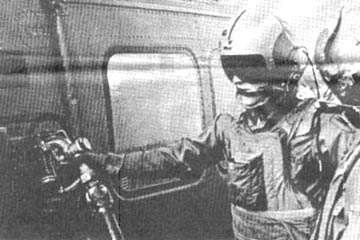 |
 |
BOLT BLUES - Specialist 5 Carl Fuerst of Wilmington, Calif., changes a worn bolt on one of the command and control helicopter’s machineguns. Fuerst is the C&C crew chief and is responsible for day-to-day maintenance and checks. |
Page 6 TROPIC LIGHTNING NEWS June 2, 1969
DISCOM Handles It
Support Is The Word
PFC John Genitti
TAY NINH – The Division Support Command
(DISCOM) in Tay Ninh base
camp handles everything from steam rollers to laundry detergent, and most things
found in between.
The Division Support Command is responsible for all the logistical
support for the 1st Brigade.
Under the command of Major Samuel Malave of San Juan, P.R.,
DISCOM supplies and supports the elements of the Division and all other major
units in Tay Ninh.
“Our unit,” said Major Malave, “is largely responsible for
the supplying and operating of the post exchange facilities, the laundry,
transportation, medical support, the ammunition and refuel points.”
DISCOM is a large organization which includes Company D of the 25th
Medical Battalion and the 159th Aviation Dustoffs. Also attached directly
to DISCOM is Company B, 725th Maintenance Battalion which services DISCOM’s
500 pieces of equipment.
“One of our largest functions, however, is the regulation of
convoys that come in and out of Tay Ninh,” Major Malave said.
The co-ordination of these convoys is a major task in itself.
Every day, a main logistical convoy arrives from Cu Chi and Long Binh with
supplies for Tay Ninh. These convoys carry everything needed for the base
camp’s operation, including fuel, clothing, chow, equipment and beer and soda.
Each morning, the convoy arrives and Major Malave is at the gate to
make sure the correct number of vehicles are there. He is in constant
contact with unit leaders on the ground and in the air.
In less than an hour and a half, the convoy is off-loaded, the
drivers have eaten chow, and their vehicles are inspected and positioned for the
return trip to Cu Chi or Long Binh.
One of the main reasons for the success of DISCOM is that all
personnel are cross-trained in every phase of the operation. In the event
Major Malave cannot meet a convoy, his operations NCO, Sergeant First Class
Willie Brown, Fayetteville, N.C., takes over the duties of getting the convoy
organized and off again.
“Once in a while it seems as if we get awfully busy, because we
get convoys in from the mountain, the fire support bases, as well as the one
from Cu Chi and Long Binh, all at the same time,” said Sergeant Brown, “but
we can always get them off-loaded and started on their way again.”
“This staff is the best there is,” said Major Malave, “they
know the operation of the unit very well and can handle almost any emergency
that may arise.”
| A SNIPER’S SHOTS bring an infantry platoon leader to the front to survey his men under fire. Lieutenant Albert E. Dare of Warren, Mich., was leading his men on reconnaissance near Fire Support Base Stuart when the enemy fire was encountered. (PHOTO BY SP4 R. B. WILLIAMS) |
 |
Manchus Praise Officers’ Valor in Frontier City Battle
TAY NINH - The enlisted men of Charlie Company, 4th Battalion, 9th
Infantry Manchus, emerging from the aftermath of the recent battle for Frontier
City near the Cambodian border, spoke with unabashed pride for their command
group.
“Our Commanding Officer, Captain Ramon T. Pulliam of Columbus,
Ga., was all over the bunker line making sure no one was hit,” exclaimed
Warren Johnson, an expressive Specialist 4 from Charlotte, N.C. “He was
risking his life,” the machine gunner emphasized. “I’ve never seen a man
like that before.”
“At one point in the battle,” related Johnson, who spent a busy
night shredding lines of charging Viet Cong with bursts of 7.62mm projectiles,
“the captain stopped by my bunker and yelled, ‘Gonna give ‘em - Johnny,
gonna give ‘em -!’ It made me feel so good.”
While the commanding officer was delivering encouragement,
ammunition, and directions to his harassed bunker line, the Manchu operations
officer, Major Harry L. Ray of Dillon, Mont., and artillery forward observer,
First Lieutenant Kenneth Montoya of Oak Harbor, Wash., remained atop the 20 foot
high observation tower directing support fire for the well-entrenched perimeter.
Ray concentrated mini-gun and rocket fire from several Huey-Cobra
helicopter gunships and a “Spooky” gunship, and Montoya directed 105mm,
175mm, and eight-inch artillery rounds from fire support bases to within 30
meters of the perimeter.
According to radio-telephone operator Private First Class Burton
Spears of Nashville, Tenn., “Much of Charlie Company’s success was due to
the forward observer’s expertise in bringing artillery fire on the enemy.”
Weapons platoon ammo bearer Specialist 4 Melvin Lingle of Hershey,
Pa., was amazed even more by the nerve of the major and forward observer than by
their startling accuracy.
Lingle, putting on a brilliant show despite being in his first
heavy battle, was earning a Bronze Star commendation by dashing between the
second gun parapet and the company ammo dump with 81mm mortar rounds in his
arms.
“I heard some rocket-propelled grenades whizzing through the
air,” related the three-month veteran. “Some were going nearly
straight up and I thought the Viet Cong were firing awfully high until I
realized the tower was the target.”
Rocket-propelled grenades weren’t the only element of the enemy
arsenal reaching for the structure.
“So many small arms’ tracers were bouncing off of the tower,”
Lingle illustrated, “that it looked like a giant Fourth of July sparkler.”
Killer Eye ‘Sees’ All Booby Traps
In Commanders’ Combat Note 29 Tropic Lightning Commander Major
General Ellis W. Williamson called attention to a simple method of detecting
trip wires and destroying the accompanying booby trap.
The device is called Killer Eye and consists of the eye bolt
lifting plug located in the fuze well of eight-inch artillery ammunition.
The lifting plug is attached to a 50-foot length of rope, WD1-TT
jacketed field telephone wire to the lifting ring. Claymore wire is
preferred because of its greater flexibility.
As a soldier moves into a suspected area he searches by throwing
the Killer Eye out to his front as far as possible. He then assumes a
prone position and retrieves the Killer Eye. Any trip wires present will
be snagged by the plug as it passes over them, and the booby trap will be
detonated.
| Highway safety in the Republic of Viet Nam is
especially the business of the United States Army vehicle driver. Courtesy is extra-important in situations where roads diminish randomly to a single lane, where taxis, busses and three-wheeled vehicles are likely to stop in the road without warning. Remember, many Vietnamese do not realize your vehicle requires time and distance to stop. Drive defensively at all times. |
Page 7 TROPIC LIGHTNING NEWS June 2, 1969
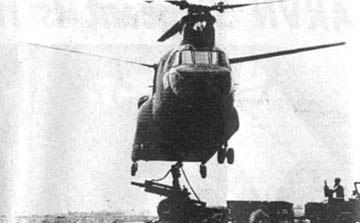 |
THE HOOK-UP IS MADE – A 105mm Howitzer, one of the two at Frontier City manned by artillerymen of B Battery, 7th Battalion, 11th Artillery, is connected to a Muleskinner Chinook. |
| GOING UP - Carrying the 5,000 pound artillery piece as if it were a toy, the Chinook and the howitzer go airborne as the “hooker” man runs to avoid the winds caused by the huge bird. | 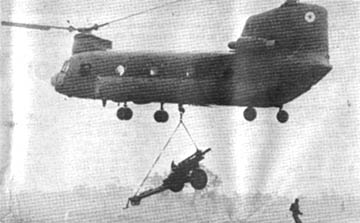 |
Frontier City Falls But Not To Charlie
Feature By SP4 Pete Freeman
TAY NINH – Patrol Base Frontier City, the scene of an impressive
U.S. victory over the North Vietnamese, is now history.
Tropic Lightning infantrymen from Charlie Company, 4th Battalion,
9th Infantry Manchus and two 105mm howitzer gun sections from “Battling
Bravo” Battery, 7th Battalion, 11th Field Artillery, pulled out of the small
patrol base May 15.
Located sixteen miles south of Tay Ninh on the northern edge of the
“Angel’s Wing” sector of the South Vietnam-Cambodia border, Frontier City
was situated in a key tactical location. Their second night there, the men
took on two battalions of enemy troops. Two hundred and thirteen North
Vietnamese soldiers lost their lives that night in what was one of the hardest
fought battles of the Vietnam War.
Seven other times during their three week-stay, Frontier City was
hit with enemy mortars or rockets. No American casualties resulted from
any of the attacks. One night Frontier City was surrounded by an estimated
North Vietnamese battalion. This time, however, fast artillery fire sent
the enemy soldiers fleeing back to their sanctuary.
To the very end, the enemy harassed the men of Frontier City.
The morning of the clearance operation, the men rose at 4:00 a.m. to begin the
move. Chinook helicopters from the 25th Aviation Battalion’s
Muleskinners began airlifting everything out. Eighteen sorties were flown
in all. At 12:30 p.m. just as one of the last sorties was about to be
picked up, mortars began exploding in and around the practically deserted patrol
base. Over twenty mortars came in as the enemy harassed Frontier City for
the last time.
Artillery fire was called in from nearby Fire Support Base
Sedgwick. Cannoneers from Charlie Battery, 7th Battalion, 11th Field
Artillery, poured out fast, accurate fire and again silenced the enemy mortar
tubes, but not before eleven more North Vietnamese were killed by the fire.
Specialist 4 Daniel E. Scott, a Bravo Battery cannoneer from Bell
Gardens, Calif., said, “The memories I have of Frontier City will stay in my
mind forever.”
Staff Sergeant Ronald Weers of Louisburg, Kan., who was in charge
of the two howitzers that serviced Frontier City, stated, “We definitely
taught the enemy a lesson while we were here and proved that effective artillery
fire along with the infantry and gunships all working together is an unbeatable
combination against enemy ground forces.”
 |
| TROPIC LIGHTNING ARTILLERYMEN load 105mm artillery rounds onto a Chinook before departing Patrol Base Frontier City. |
 |
| FRONTIER CITY FALLS - The NVA couldn’t do it. The GI had to. After throwing back attack after attack, Frontier City finally dies. |
Page 8 TROPIC LIGHTNING NEWS June 2, 1969
| RE-ENACTING HIS OJT flying, Sergeant First Class Hai Lenan, attached to the 2d Brigade, shows how he singlehandedly saved a damaged chopper. (PHOTO BY SP5 DOUG ELLIOTT) |
 |
ARVN Sergeant Is Hero and Patriot
SP5 Doug Elliott
CU CHI-Sergeant First Class Hai Lenan was wounded six times while
fighting with the Army of Vietnam against the insurgent Viet Cong. The
last wound proved fatal. Shortly before being killed the Sergeant related
his experience of learning to fly a helicopter under the most difficult
conditions.
While on an eagle flight with elements of the 2d Brigade, the
soft-spoken Vietnamese soldier was riding a chopper hit by enemy fire.
The aircraft commander was killed instantly, while the pilot was
critically wounded. Hai leaped to the front, leaned over the aircraft
commander, and managed to straighten out the chopper’s flight.
Having never flown any type of aircraft before, Hai had his trouble
mastering all the techniques needed to stay airborne in mere seconds. The
wounded pilot, although incapable of helping gave the sergeant some quick
instructions, and Hai’s degree in engineering came in handy.
Leaving the eagle flight formation, Hai headed the chopper in the
direction of Cu Chi and medical help for the crew. None of the
navigational instruments was working.
Help had to come for the crew. Recognizing the ground below
Hai headed for Tan Son Nhut Air Base, found it, and managed to land the craft
and get aid for the crew.
At this point, Hai calmly returned to the unit he was working with
at the time, the 1st Battalion, 27th Infantry, as if nothing had happened.
Finally his story leaked out.
Attached at his death to Lieutenant Colonel Duane R. Tague’s 2d
Battalion, 34th Armor, Hai dedicated himself to his country’s service.
Resupply: An Operation That Never Ends
SP4 Pete Freeman
TAY NINH – The ammunition section from Headquarters Battery, 7th
Battalion, 11th Field Artillery, has a vital function to perform, and they must
be prepared to act quickly whenever resupply of any sort is needed in the field.
The primary task of “ammo” section is to resupply artillery
ammunition to the three 7th Battalion, 11th Field Artillery’s firing batterys,
Alpha, Bravo, and Charlie.
In one month, the “ammo” section has resupplied thousands of
rounds of 105mm howitzer ammunition. This, of course, is a big
never-ending operation, but there is much more to their duties.
In addition to ammunition, they also resupply practically
everything necessary to a unit located at a fire support base. Such things
as food and soda rations, ice, water, diesel fuel, sand bags and lumber, to
mention a few. As First Lieutenant Mark Fiedler of Denver, Colo., put it:
“We supply them with everything from the kitchen sink to Mom’s apple pie.”
Fiedler is the ammunition officer for the 7th Battalion, 11th Field Artillery,
and is in charge of all their resupply.
Resupply operations are accomplished by one of two methods.
Truck convoy or air supply. The “ammo” trucks go quite frequently on
“ammo runs” to the fire support bases, sometimes making two runs in a single
day.
But in recent moves of the firing batteries to more distant
locations, more and more resupply by air has been made a necessity. In
order to accomplish this mission, the “ammo” section coordinates with the
CH-47 Chinooks from the 25th Aviation Battalion, Cu Chi, and with the CH-54 Sky
Cranes from the 22nd Aviation Battalion, Vung Tau. With the, powerful
Chinooks and Sky Cranes “doing their thing,” the “ammo” section has the
job of getting the ammo to the Viking Resupply Pad in Tay Ninh base camp and
making sure all ammunition and rations are properly secured by the airlift cargo
nets. Then, after calling in a chopper, they hook up the nets in the midst
of swirling, stinging winds caused by the huge resupply choppers and the sortie
is on the way.
In addition to resupplying ammo and rations, the “ammo” section
is also called upon to aid in movements. Whenever a firing battery from
the 7th Battalion, 11th Field Artillery, moves out to a new position, they go
with them, carrying extra ammo and anything else that has to be moved.
When Alpha and Charlie batteries moved into new positions, the Headquarters
Battery “ammo” section was there in both instances and making sure the guns
had sufficient ammunition.
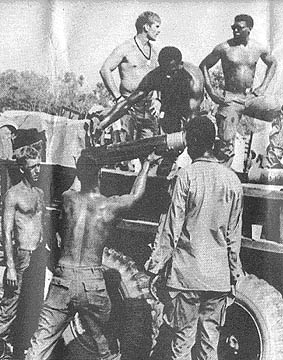 |
HOT WORK - After moving into a new position to build FSB Crook, ammo humpers unload a truck load of 105 rounds. (PHOTO BY SP4 PETE FREEMAN) |
Underground NVA Agents Uncovered
TAY NINH - Alpha Company of the 4th Battalion, 23d Infantry, was
engaged in an underground operation recently that accounted for 15 dead NVA.
While on a sweep three miles south of Tay Ninh City, the Tomahawks
happened on a group of graves. Each of the unearthed bodies bore the green
pajama uniform so voguish now with NVA units.
“We estimate that that these enemy died as a result of recent
artillery fire in the area” a spokesman for the Tomahawks said.
It was also estimated that the graves were about 48 hours old.
Six VC Fall To Wolfhounds
DAU TIENG - Charlie and Delta companies, 1st Battalion, 27th
Infantry, working together in a wooded area near here, accounted for six enemy
dead recently while on a reconnaissance-in-force operation.
Charlie Company, set up in ambush, successfully engaged two Viet
Cong soldiers approximately 25 meters north of their position. The action
resulted in one enemy dead and one captured AK-47.
“The VC were apparently harvesting vegetables,” said Captain
Lloyd Yoshina of Honolulu, the company commander. “We’re trying to
beat the enemy at his own game with these ambushes. We’re making him
afraid to return to his cache sites and infiltration routes.”
Meanwhile, the Wolfhounds’ Delta Company, working in the same
general area, accounted for three enemy soldiers killed and the capture of one
AK-47 rifle.
In one incident, Delta Company killed one VC soldier when they
engaged two of the enemy riding bicycles. The company later killed two
North Vietnamese Army regulars when they engaged an estimated four enemy
soldiers with small arms and artillery.
 |
| TAKING OFF from the Viking Resupply Pad at Tay Ninh is this powerful Sky Crane. It is hoisting artillery ammunition destined for a patrol base. (PHOTO BY SP4 PETE FREEMAN) |
Thanks to
Mack D. Gooding, 15th PID, 1st Bde., for sharing this issue,
Kirk Ramsey, 2nd Bn., 14th Inf. for creating this page.
This page last modified 8-12-2004
©2004 25th Infantry Division Association. All rights reserved.